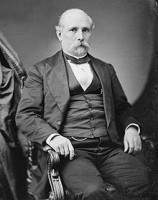|
|
||||
|
|
||||
|
Copyright © 1996- MSGenWeb Project, All Rights Reserved
|
||||
|
Some
files contained within this web site are .PDF files. You must have Adobe Reader to access these files. You can download Adobe Reader by clicking here or the logo. |
 |
|||||
Two major battles occurred in Corinth, the first in May 1862, after the Battle of Shiloh, and the second in the fall of that year, when fighting broke out between forces helmed by Ulysses S. Grant and those led by Earl Van Dorn. The latter battle left more than eight hundred soldiers dead and the city under Union control. Corinth was also home to a Union camp for escaped slaves and served as a major hospital center for the Confederate wounded. Corinth National Cemetery houses the remains of Civil War soldiers from fifteen states. By 1880 the county’s population had increased to 14,272, with whites now comprising only 69 percent of the total. As in most of northeastern Mississippi, Alcorn County’s farms were relatively small and mostly cultivated by their owners. In 1880 Alcorn ranked high among Mississippi counties in livestock and tobacco production, while corn and wheat output remained average and cotton production low. Although Alcorn had sixty-five manufacturing firms at this time, most were fairly small, and the county’s industrial sector employed only 130 men and 9 women. Whitfield Manufacturing was Alcorn’s first textile factory. Alcorn has a unique early history with regard to women in academia. Born in 1850 in what became Alcorn, Modena Lowrey Berry had an extraordinary career as an administrator at Tippah County’s Blue Mountain College from 1873 to 1934. Her father, educator and Confederate general Mark Perrin Lowrey, had helped establish Blue Mountain in 1873. Corona College, one of the South’s first higher education institutions open to women, opened in Corinth in 1857. In the early twentieth century Alcorn experienced significant growth. By 1910 the county’s population had reached 18,159. Despite the predominance of small farms, Alcorn ranked among the top third of Mississippi’s counties in average farm size. Most of Alcorn’s agricultural lots were plantations that had been subdivided into farms averaging about one hundred acres each. During this era more than half of Alcorn’s white farmers could claim ownership of their land, while only a small percentage of black farmers were landholders. By 1900 Alcorn County had sixty-six manufacturing establishments, employing 455 men, 126 women, and 17 children. The 1916 religious census showed that the largest denominations in Alcorn were the Methodist Episcopal Church, South; the Southern Baptist Convention; and the Missionary Baptists. The Colored Methodist Episcopal Church and the Churches of Christ had significant congregations as well. |
|||||
|
Copyright Notice:
All files on this site are copyrighted by their creator. They may be linked to but may not be reproduced electronically or otherwise without specific permission from the county host and/or the contributor. Although public information is not in and of itself copyrightable, the format in which they are presented, the notes and comments, etc., are. It is however, quite permissible to print or save the files to a personal computer for personal use ONLY. |
 Last
Up-dated:
12/19/2023 02:08 PM -0600
Last
Up-dated:
12/19/2023 02:08 PM -0600

